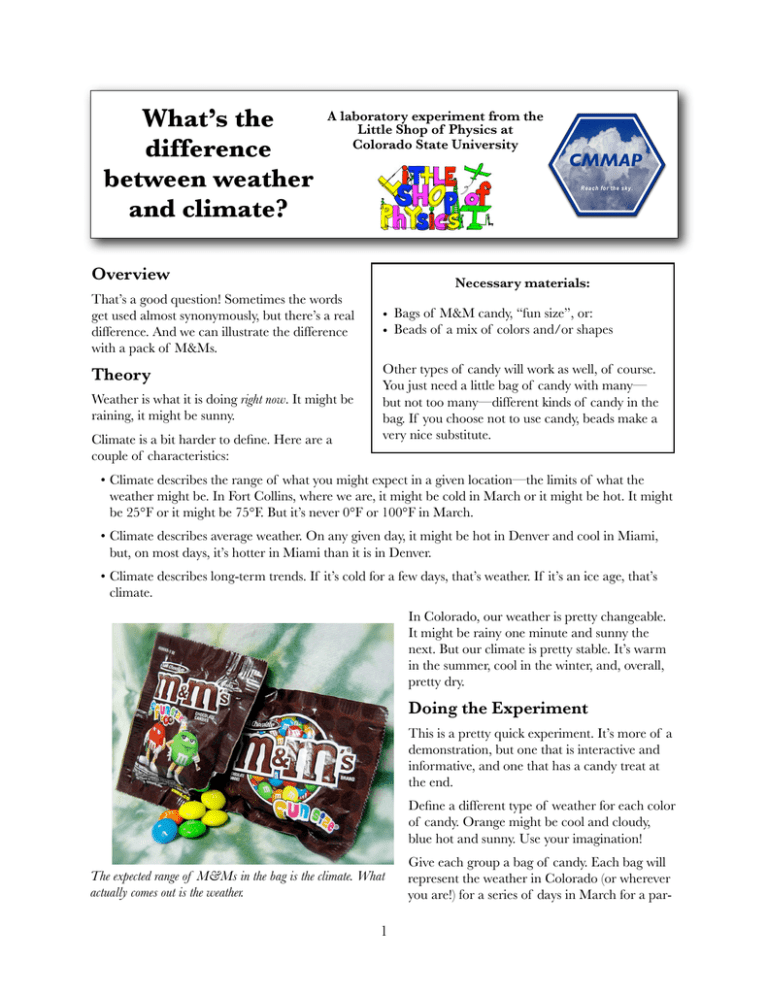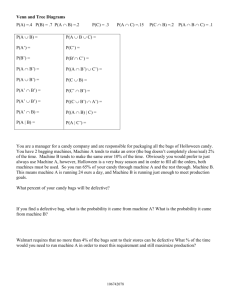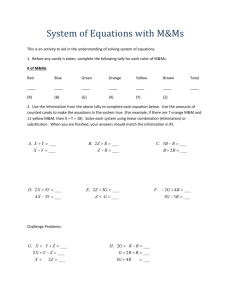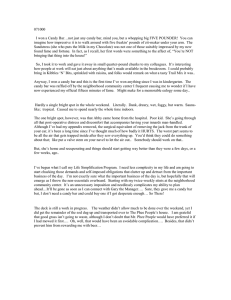What’s the difference between weather and climate?
advertisement

What’s the difference between weather and climate? A laboratory experiment from the Little Shop of Physics at Colorado State University Reach for the sky. Overview That’s a good question! Sometimes the words get used almost synonymously, but there’s a real difference. And we can illustrate the difference with a pack of M&Ms. Theory Weather is what it is doing right now. It might be raining, it might be sunny. Climate is a bit harder to define. Here are a couple of characteristics: CMMAP Necessary materials: • Bags of M&M candy, “fun size”, or: • Beads of a mix of colors and/or shapes Other types of candy will work as well, of course. You just need a little bag of candy with many— but not too many—different kinds of candy in the bag. If you choose not to use candy, beads make a very nice substitute. • Climate describes the range of what you might expect in a given location—the limits of what the weather might be. In Fort Collins, where we are, it might be cold in March or it might be hot. It might be 25°F or it might be 75°F. But it’s never 0°F or 100°F in March. • Climate describes average weather. On any given day, it might be hot in Denver and cool in Miami, but, on most days, it’s hotter in Miami than it is in Denver. • Climate describes long-term trends. If it’s cold for a few days, that’s weather. If it’s an ice age, that’s climate. In Colorado, our weather is pretty changeable. It might be rainy one minute and sunny the next. But our climate is pretty stable. It’s warm in the summer, cool in the winter, and, overall, pretty dry. Doing the Experiment This is a pretty quick experiment. It’s more of a demonstration, but one that is interactive and informative, and one that has a candy treat at the end. Define a different type of weather for each color of candy. Orange might be cool and cloudy, blue hot and sunny. Use your imagination! The expected range of M&Ms in the bag is the climate. What actually comes out is the weather. 1 Give each group a bag of candy. Each bag will represent the weather in Colorado (or wherever you are!) for a series of days in March for a par- ticular year. You might even assign years—one bag represents 1996, one 2000... Ask each group to tear open a corner of their bags, and tip out one piece of candy. That’s the weather on March 1. Now, ask each group what they got. In some groups (that is, in some years...) the M&M is orange (March 1 was cool and cloudy); in others, it’s blue (March 1 was hot and sunny.) That’s weather. On a given day in a given year, you just can’t predict what the weather will be. Now, have each group pour out all of their candy and count: How many orange? How many blue? You'll find that there are some differences between groups, but the differences are reasonably small. Some groups may get a larger percentage orange candy, others will get more blue. But no one will get all orange or all blue! If you look at the weather over a longer period of time, patterns start to emerge. You are starting to pin down the climate.... Now, compute an average number for each color in all of the bags. This is climate, the average weather, what you expect. If you give someone a fresh bag, you can't predict the weather—whether the next candy out of the bag will be blue or orange—but you can predict trends in the weather. You can say, with confidence, that there won't be 10 orange candies in a row. That would be very unlikely! If you want a nice extension, you can compare different types of candy. Give some of your groups M&Ms, some of them another kind of candy. That would correspond to different climates. When you are done, ask your students the question we started with: What is the difference between weather and climate? Summing Up This is really a demonstration, but we have found it helpful in demonstrating the difference between the unpredictable fluctuations of the weather and the long-term predictable average of the climate. For More Information CMMAP, the Center for Multi-Scale Modeling of Atmospheric Processes: http://cmmap.colostate.edu Little Shop of Physics: http://littleshop.physics.colostate.edu 2



